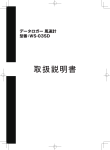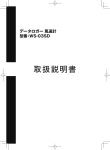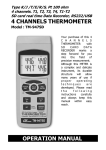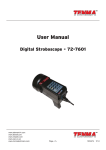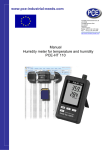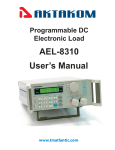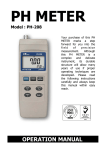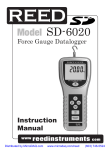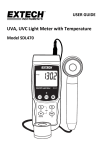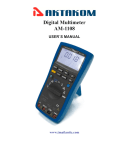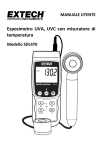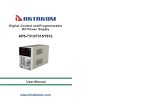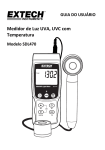Download ATE-1034
Transcript
USER MANUAL Hot Wire Anemometer ATE-1034 www.tmatlantic.com TABLE OF CONTENTS 1. FEATURES................................................................................ 1 2. SPECIFICATIONS...................................................................... 2 3. FRONT PANEL DESCRIPTION..................................................... 6 3-1 Display............................................................................... 6 3-2 Power Button ( ESC, Backlight Button )................................. 6 3-3 Hold Button ( Function Button, Next Button )........................ 6 3-4 REC Button ( Enter Button, Unit Button )............................. 6 3-5 SET Button ( ˑ Button, Time check Button )......................... 6 3-6 Logger Button ( ˏ Button, Sampling time check Button )....... 6 3-7 Probe input socket.............................................................. 6 3-8 Type K/J Probe Input Socket............................................... 6 3-9 SD card socket.................................................................... 6 3-10 RS-232 Output Terminal.................................................... 6 3-11 Reset Button..................................................................... 6 3-12 DC 9V Power Adapter Input Socket..................................... 6 3-13 Battery Compartment/Cover............................................... 6 3-14 Battery Cover's Screws...................................................... 6 3-15 Stand............................................................................... 6 3-16 Tripod Fix Nut................................................................... 6 3-17 Probe Plug........................................................................ 6 3-18 Telescope Probe............................................................... 6 3-19 Sensing Head................................................................... 6 4. MEASURING PROCEDURE.......................................................... 7 4-1 Function selection .............................................................. 7 4-2 Air velocity/Temp. measurement.......................................... 8 4-3 Type K/J thermometer ....................................................... 10 4-4 Data Hold...........................................................................11 4-5 Data Record ( Max./ Min. reading ).......................................11 4-6 LCD Backlight ON/OFF.........................................................12 5. DATALOGGER...........................................................................12 5-1 Preparation before execute datalogger function.....................12 5-2 Auto Datalogger ( Set sampling time ʁ 1 second )...............13 5-3 Manual Datalogger ( Set sampling time = 0 second )............ 14 5-4 Check time information........................................................14 5-5 Check sampling time information..........................................15 5-6 SD Card Data structure........................................................15 6. Saving data from the SD card to the computer............................ 16 7. ADVANCED SETTING.................................................................17 7-1 Set clock time ( Year/Month/Date, Hour/Minute/ Second )......18 7-2 Decimal point of SD card setting...........................................19 7-3 Auto power OFF management .............................................19 7-4 Set beep Sound ON/OFF..................................................... 20 7-5 Select the thermometer type to Type K or Type J.................. 20 7-6 Select the temperature unit to ɗ or ə ...............................21 7-7 Set sampling time ..............................................................21 7-8 SD memory card format...................................................... 21 8. POWER SUPPLY from DC ADAPTER............................................ 22 9. BATTERY REPLACEMENT...........................................................22 10. SYSTEM RESET.......................................................................23 11. RS232 PC serial interface.........................................................23 12. Optional Type K Temp. probe.................................................. 25 www.tmatlantic.com 1. FEATURES * Combination of hot wire and standard thermistor, deliver rapid and precise measurements even at low air velocity value. * Slim probe, ideal for grilles & diffusers. * Air velocity : m/s, Ft/min, Km/h, Knot, Mile/h, * Air temperature ( ɗ, ə ) * Air Temp. used thermistor sensor, fast response time. * Type K, Type J thermocouple thermometer. * Real time SD memory card Datalogger, it Built-in Clock and Calendar, real time data recorder , sampling time set from 1 second to 3600 seconds. * Manual datalogger is available ( set the sampling time to 0 ), during execute the manual datalogger function, it can set the different position ( location ) No. ( position 1 to position 99 ). * Innovation and easy operation, computer is not need to setup extra software, after execute datalogger, just take away the SD card from the meter and plug in the SD card into the computer, it can down load the all the measured value with the time information ( year/month/date/ hour/minute/second ) to the Excel directly, then user can make the further data or graphic analysis by themselves. * SD card capacity : 1 GB to 16 GB. * LCD with green light backlight, easy reading. * Can default auto power off or manual power off. * Data hold, record max. and min. reading. * Microcomputer circuit, high accuracy. * Power by UM3/AA ( 1.5 V ) x 6 batteries or DC 9V adapter. * RS232/USB PC COMPUTER interface. * Separate probe, easy for operation of different measurement environment. 1 www.tmatlantic.com * Applications : Environmental testing, Air conveyors, Flow hoods, Clean rooms, Air velocity, Air balancing, Fans/motors/blowers, Furnace velocity, Refrigerated case, Paint spray booths. 2. SPECIFICATIONS 2-1 General Specifications Circuit Custom one-chip of microprocessor LSI circuit. Display LCD size : 52 mm x 38 mm LCD with green backlight ( ON/OFF ). Measurement Air velocity: Unit m/s (meters per second) Km/h ( kilometers per hour ) Ft/min ( FPM, feet per minute ) Knots ( nautical miles per hour ) Mile/h ( mph, miles per hour ) Air temperature: ɗ, ə Type K/ Type J thermometer. ɗ, ə Sensor Air velocity & Air flow : Structure Tiny glass bead thermistor. Air temperature : Thermistor. Type K, Type J thermometer : Type K/J thermocouple probe. * Probes are optional. 2 www.tmatlantic.com Datalogger Auto Sampling Time Setting range Manual 1 second to 3600 seconds @ Sampling time can set to 1 second, but memory data may loss. Push the data logger button once will save data one time. @ Set the sampling time to 0 second. @ Manual mode, can also select the 1 to 99 position ( Location ) no. Memory Card Advanced setting SD memory card. 1 GB to 16 GB. * It recommend use memory card ʀ 4 GB. * Set clock time ( Year/Month/Date, Hour/Minute/ Second ) * Decimal point of SD card setting * Auto power OFF management * Set beep Sound ON/OFF * Set thermometer type to Type K or Type J * Set temperature unit to ɗ or ə * Set sampling time * SD memory card Format Temperature Compensation Automatic temp. compensation for the Anemometer function and the type K/J thermometer. Data Hold Freeze the display reading. Memory Recall Maximum & Minimum value. Sampling Time Approx. 1 second. of Display Data Output RS 232/USB PC computer interface. * Connect the optional RS232 cable UPCB-02 will get the RS232 plug. * Connect the optional USB cable USB-01 will get the USB plug. Operating 0 to 50 ɗ. Temperature Operating Less than 85% R.H. Humidity 3 www.tmatlantic.com Power Supply Power Current Weight Dimension * AAlkaline or heavy duty DC 1.5 V battery ( UM3, AA ) x 6 PCs, or equivalent. * ADC 9V adapter input. ( AC/DC power adapter is optional ). Normal operation ( w/o SD card save data and LCD Backlight is OFF) : Approx. DC 30 mA. When SD card save the data and LCD Backlight is OFF) : Approx. DC 50 mA. 515 g/ 1.13 LB. Main instrument : 203 x 76 x 38 mm Telescope Probe : Round, 12 mm Dia x 280 mm ( min. length ). Round, 12 mm Dia x 940 mm ( max. length ). Accessories Included Optional Accessories * Instruction manual........................1 PC * Telescope Probe........................... 1 PC * Hard carrying case ( CA-06 )..........1 PC SD Card ( 1 G ) SD Card ( 2 G ) Type K thermocouple probe. AC to DC 9V adapter. USB cable, USB-01. RS232 cable, UPCB-02. Data Acquisition software, SW-U801-WIN. 4 www.tmatlantic.com 2-2 Electrical Specifications (23± 5 ɗ) Air velocity Measurement Range Resolution Accuracy m/s 0.2 to 5.0 m/s 0.01 m/s ± ( 5% + a ) 5.1 to 25.0 m/s 0.1 m/s reading Km/h 0.70 to 18.00 km/h 0.01 Km/h 18.0 to 72.0 km/h 0.1 Km/h or Mile/h 0.50 to 11.20 mph 0.01 mph ± ( 1% + a ) ( mph ) 11.2 to 44.7 mph 0.1 mph full scale Knot 0.40 to 9.70 knot 0.01 Knot 9.7 to 38.8 knot 0.1 Knot Ft/min 40-3940 ft/min 1 Ft/min @ a = 0.1 m/s, 0.3 km/h, 0.2 mile/h, 0.2 knot, 20 ft/min Note: m/s - meters per second km/h - kilometers per hour ft/min - feet per minute knot - nautical miles per hour mile/h - miles per hour (international knot) Air temperature Measuring Range Resolution Accuracy 0 ɗ to 50 ɗ/32 ə to 122 ə 0.1 ɗ/0.1 ə ± 0.8 ɗ/1.5 ə Type K/J thermometer Sensor Type Type K Resolution Range Accuracy 0.1 ɗ -50.0 to 1300.0 ɗ ± ( 0.4 % + 0.5 ɗ ) -50.1 to -100.0 ɗ ± ( 0.4 % + 1 ɗ ) 0.1 ə -58.0 to 2372.0 ə ± ( 0.4 % + 1 ə ) -58.1 to -148.0 ə ± ( 0.4 % + 1.8 ə ) Type J 0.1 ɗ -50.0 to 1100.0 ɗ ± ( 0.4 % + 0.5 ɗ ) -50.1 to -100.0 ɗ ± ( 0.4 % + 1 ɗ ) 0.1 ə -58.0 to 2012.0 ə ± ( 0.4 % + 1 ə ) -58.1 to -148.0 ə ± ( 0.4 % + 1.8 ə ) @ Above specification tests under the environment RF Field Strength less than 3 V/M & frequency less than 30 MHz only. 5 www.tmatlantic.com 3. FRONT PANEL DESCRIPTION Fig. 1 3-1 Display 3-2 Power Button ( ESC, Backlight Button ) 3-3 Hold Button ( Function Button, Next Button ) 3-4 REC Button ( Enter Button, Unit Button ) 3-5 SET Button ( ˑ Button, Time check Button ) 3-6 Logger Button ( ˏ Button, Sampling time check Button ) 3-7 Probe input socket 3-8 Type K/J thermometer socket 3-9 SD card socket 3-10 RS-232 Output Terminal 3-11 Reset Button 3-12 DC 9V Power Adapter Input Socket 3-13 Battery Compartment/Cover 3-14 Battery Cover Screws 3-15 Stand 3-16 Tripod Fix Nut 3-17 Probe Plug 3-18 Telescope Probe 3-19 Sensing Head 6 www.tmatlantic.com 4. MEASURING PROCEDURE 4-1 Function selection 1) Turn on the meter by pressing the " Power Button " ( 3-2, Fig. 1 ) momentarily. * Pressing the " Power Button " ( 3-2, Fig. 1 ) continuously and > 2 seconds again will turn off the meter. 2) The meter can select 2 kind function as : a. Air velocity/Temp. d. Type K/J Thermometer Pressing the " Function Button " ( 3-3, Fig. 1 ) continuously ( not release the button ), the Display will show the following text in sequence : Air tP Air velocity/Temp. measurement Type K/J Thermometer measurement Until the Display show the desired mode ( Function ), just release the " Function Button " ( 3-3, Fig. 1 ), the meter will execute this function with default. 7 www.tmatlantic.com 4-2 Air velocity/Temp. measurement 1) Important information of using the Telescope Probe * When the probe is not used, the " Sensor cover " should slide to the up position. When the probe is not used, the " Sensor cover " should slide to the up position. Fig. 2 Probe Handle * When begin to use the probe, a. Slide the sensor cover to the down position, let the air velocity sensor to contact the air, refer Fig. 3. b. Extent the telescope probe to the convenient length ,refer to Fig. 3 air velocity sensor ( do not touch by fingers or tools ) Fig. 3 " Sensor cover " slide to the low position when make the measurement Probe Handle 8 www.tmatlantic.com * Do not use the fingers or any tools to touch the air velocity sensor, otherwise the meter may happen the permanent damage without warranty. * Direction of the sensor head : There is a mark on the top of the " Sensor Head ", When make the measurement, then this mark should against the measured wind, refer Fig. 4. When sensor head face against the measurement air, then the upper display will show the air velocity value. The lower display will show the temperature value. Direction mark should face the measured wind. sensor head ( side view ) Fig. 4 Probe Handle 2) Function select to " Air velocity/Temp. " measurement. 3) Plug the " Probe Plug " ( 3-17, Fig. 1 ) into the " Probe Input Socket " ( 3-7, Fig. 1 ). Power on the meter by pressing the " Power Button " ( 3-2, Fig. 1 ) once, 4) Hold the " Telescope Probe " ( 3-18, Fig. 1 ) by hand and let the " Sensing Head " ( 3-19, Fig. 1 ) face against the measuring air flow source, then the Display ( 3-1, Fig. 1 ) will show air velocity directly. At the same time, the lower Display will show the air temperature value. 9 www.tmatlantic.com Measuring Consideration : The mark on the sensor head indicates the direction that " need to face against the air flow. Change the Air velocity unit Air velocity unit are : m/s, FPM ( Ft/min ), Km/h, Knots, mph ( Mile/h ) If intend to change the Air velocity unit, press the Unit Button " ( 3-4 ) continuously, the unit will change from m/s to Km/h, mph, Knot, FPM in sequence, until the desired unit is present on the Display release the " Unit Button ", the select unit will save into the memory with default. Change the temperature unit ( ɗ, ə ) The meter Temp. display unit is defaulted to " ɗ ". If intend to let the meter's temperature unit default to " ə " , then please refer chapter 7-6 ( page 21 ). 4-3 Type K/J thermometer 1) Function select to " Type K/J thermometer " 2) Plug the Thermocouple Temp. Probe ( Type K Temp. probe pr Type J Temp. probe, optional ) into " Type K/J Probe Input Socket " ( 3-8, Fig. 1 ) The Display will show the measuring value that sensing from the Temp. probe. 3) If the Display show the indicator " K ", it is ready for Type K thermometer. If the Display show the indicator " J ", it is ready for Type J thermometer. 10 www.tmatlantic.com Remark : The meter is defaulted to " Type K thermometer ". If intend to select the " Type J thermometer with default , please refer chapter 7-5 ( page 20 ). 4-4 Data Hold During the measurement, press the " Hold Button " ( 3-3, Fig. 1 ) once will hold the measured value & the LCD will display a " HOLD " symbol. Press the " Hold Button " once again will release the data hold function. 4-5 Data Record ( Max., Min. reading ) 1) The data record function records the maximum and minimum readings. Press the " REC Button " ( 3-4, Fig. 1 ) once to start the Data Record function and there will be a " REC " symbol on the display. 2) With the " REC " symbol on the display : a) Press the " REC Button " ( 3-4, Fig. 1 ) once, the " REC MAX " symbol along with the maximum value will appear on the display. If intend to delete the maximum value, just press the " Hold Button " ( 3-3, Fig. 1 ) once, then the display will show the " REC " symbol only & execute the memory function continuously. b) Press the " REC Button " ( 3-4, Fig. 1 ) again, the " REC MIN " symbol along with the minimum value will appear on the display. If intend to delete the minimum value, just press the " Hold Button " ( 3-3, Fig. 1 ) once, then the display will show the " REC " symbol only & execute the memory function continuously. c) To exit the memory record function, just press the " REC " button for 2 seconds at least. The display will revert to the current reading. 11 www.tmatlantic.com 4-6 LCD Backlight ON/OFF After power ON, the " LCD Backlight " will light automatically. During the measurement, press the " Backlight Button " ( 3-2, Fig. 1 ) once will turn OFF the " LCD Backlight ". Press the " Backlight Button " once again will turn ON the " LCD Backlight " again. 5. DATALOGGER 5-1 Preparation before execute datalogger function a. Insert the SD card Prepare a " SD memory card " ( 1 G to 16 G, optional ), 7 It recommend use memory card ʀ 4 GB. insert the SD card into the " SD card socket " ( 3-9, Fig. 1). The front panel of the SD card should face against the the down case. b. SD card Format If SD card just the first time use into the meter, it recommend to make the " SD card Format " at first. , please refer chapter 7-8 ( page 21 ). * It recommend strongly, do not use memory cards that have been formatted by other meter or by a computer. Reformat the memory card with your meter. c. Time setting If the meter is used at first time, it should to adjust the clock time exactly, please refer chapter 7-1 ( page 18 ). d. Decimal format setting The numerical data structure of SD card is default used the " . " as the decimal, for example "20.6" "1000.53" . But in certain countries ( Europe ...) is used the " , " as the decimal point, for example " 20, 6 " "1000,53". Under such situation, it should change the Decimal character at first, details of setting the Decimal point, refer to Chapter 7-2, page 19. 12 www.tmatlantic.com 5-2 Auto Datalogger ( Set sampling time ʁ 1 second ) a. Start the datalogger Press the " REC Button ( 3-4, Fig. 1 ) once , the LCD will show the text " REC ", then press the " Logger Button " ( 3-6, Fig. 1 ), the " REC " will flashing, at the same time the measuring data along the time information will be saved into the memory circuit. Remark : !+ How to set the sampling time, refer to Chapter 7-7, page 21. !+ How to set the beeper sound is enable, refer to Chapter 7-4, page 20. b. Pause the datalogger During execute the Datalogger function , if press the " Logger Button " ( 3-6, Fig. 1 ) once will pause the Datalogger function ( stop to save the measuring data into the memory circuit temporally ). In the same time the text of " REC " will stop flashing. Remark : If press the " Logger Button " ( 3-6, Fig. 1 ) once again will execute the Datalogger again, the text of " REC " will flashing . c. Finish the Datalogger During pause the Datalogger, press the " REC Button " ( 3-4, Fig. 1) continuously at least two seconds, the " REC " indication will be disappeared and finish the Datalogger. 13 www.tmatlantic.com 5-3 Manual Datalogger ( Set sampling time = 0 second ) a. Set sampling time is to 0 second Press the " REC Button ( 3-4, Fig. 1 ) once , the LCD will show the text " REC ", then press the " Logger Button " ( 3-6, Fig. 1 ) once, the " REC " will flashing once and Beeper will sound once, at the same time the measuring data along the time information will be saved into the memory circuit. The lower Display will show the Position ( Location ) no. and saved into the SD card too. Remark : During execute the Manual Datalogger, press the " ˑ Button " ( 3-5, Fig, 1 ) the lower no. ( position no. ) will flashing. It can use the " ˏ Button " ( 3-6, Fig. 1) or " ˑ Button " ( 3-5, Fig. 1 ) to set the measuring position ( 1 to 99, for example room 1 to room 99 ) to identify the measurement location , the lower Display will show P x ( x = 1 to 99 ). After the position no. is selected, t press the " Enter Button " ( 3-4, Fig. 1 ) to confirm. b. Finish the Datalogger Press the " REC Button " ( 3-4, Fig. 1) continuously at least two seconds, the " REC " indication will be disappeared and finish the Datalogger. 5-4 Check time information During the normal measurement ( not execute the Datalogger ), If press " Time check Button " ( 3-5, Fig. 1 ) once , the lower LCD display will present the time information of Year, Month/Date, Hour/Minute 14 www.tmatlantic.com 5-5 Check sampling time information During the normal measurement ( not execute the Datalogger ), If press " Sampling Button " ( 3-6, Fig. 1 ) once , the lower LCD display will present the Sampling time information in second unit. 5-6 SD Card Data structure 1) When the first time, the SD card is used into the meter, the SD card will generate a folder : AHA01 2) If the first time to execute the Datalogger, under the route AHA01\, will generate a new file name AHA01001.XLS. After exist the Datalogger, then execute again, the data will save to the AHA01001.XLS until Data column reach to 30,000 columns, then will generate a new file, for example AHA01002.XLS 3) Under the folder AHA01\, if the total files more than 99 files, will generate anew route, such as AHA02\ ........ 4) The file's route structure : AHA01\ AHA01001.XLS AHA01002.XLS ..................... AHA01099.XLS AHA02\ AHA02001.XLS AHA02002.XLS ..................... AHA02099.XLS AHAXX\ ..................... Remark : XX - Max. value is 10. 15 www.tmatlantic.com 6. Saving data from the SD card to the computer ( EXCEL software ) 1) After execute the Data Logger function, take away the SD card out from the " SD card socket " ( 3-9, Fig. 1 ). 2) Plug in the SD card into the Computer's SD card slot ( if your computer build in this installation ) or insert the SD card into the " SD card adapter ". then connect the " SD card adapter " into the computer. 3) Power ON the computer and run the " EXCEL software ". Down load the saving data file ( for example the file name : AHA01001.XLS, AHA01002.XLS ) from the SD card to the computer. The saving data will present into the EXCEL software screen ( for example as following EXCEL data screens ) , then user can use those EXCEL data to make the further Data or Graphic analysis usefully. EXCEL data screen ( for example ) 16 www.tmatlantic.com EXCEL graphic screen ( for example ) 7. ADVANCED SETTING Under do not execute the Datalogger function, press the " SET Button " ( 3-5, Fig. 1 ) continuously at least two seconds will enter the " Advanced Setting " mode. then press the " Next Button " (3-3, Fig. 1 ) once a while in sequence to select the eight main function, the lower display will show : dAtE......Set clock time ( Year/Month/Date, Hour/Minute/ Second ) dEC....... Set SD card Decimal character PoFF......Auto power OFF management bEEP..... Set beeper sound ON/OFF tYPE......Select the Thermometer to Type K or Type J t-CF.......Select the Temp. unit to ɗ or ə SP-t...... Set sampling time ( Hour/Minute/Second ) Sd F..... SD memory card Format 17 www.tmatlantic.com Remark : During execute the " Advanced Setting " function, if press " Esc Button " ( 3-2, Fig. 1 ) once will exit the " Advanced Setting " function, the LCD will return to normal screen. 7-1 Set clock time ( Year/Month/Date, Hour/Minute/ Second ) When the lower display show " dAtE " 1) Press the " Enter Button " ( 3-4, Fig. 1 ) once, Use the " ˏ Button " ( 3-6, Fig. 1 ) or " ˑ Button " ( 3-5, Fig. 1 ) to adjust the value ( Setting start from Year value ). After the desired value is set, press the " Enter Button " ( 3-4, Fig. 1 ) once will going to next value adjustment ( for example, first setting value is Year then next to adjust Month, Date, Hour, Minute, Second value ). 2) After set all the time value ( Year, Month, Date, Hour, Minute, Second ), the screen will jump to " Decimal point of SD crad setting " screen ( Chapter 7-2 ). Remark : After the time value is setting, the internal clock will run precisely even Power off if the battery is under normal condition ( No low battery power ). 18 www.tmatlantic.com 7-2 Decimal point of SD card setting The numerical data structure of SD card is default used the " . " as the decimal, for example "20.6" "1000.53" . But in certain countries ( Europe ...) is used the " , " as the decimal point, for example " 20,6 " "1000,53". Under such situation, it should change the Decimal character at first. When the lower display show " dEC " 1) Use the " ˏ Button " ( 3-6, Fig. 1 ) or " ˑ Button " ( 3-5, Fig. 1 ) to select the upper value to " bASIC " or " Euro ". bASIC - Use " . " as the Decimal point with default. Euro - Use " , " as the Decimal point with default. 2) After select the upper text to " bASIC " or " Euro ", press the " Enter Button " ( 3-4, Fig. 1 ) will save the setting function with default. 7-3 Auto power OFF management When the lower display show " PoFF " 1) Use the " ˏ Button " ( 3-6, Fig. 1 ) or " ˑ Button " ( 3-5, Fig. 1 ) to select the upper value to " yES " or " no ". yES - Auto Power Off management will enable. no - Auto Power Off management will disable. 2) After select the upper text to " yES " or " no ", press the " Enter Button " ( 3-4, Fig. 1 ) will save the setting function with default. 19 www.tmatlantic.com 7-4 Set beeper sound ON/OFF When the lower display show " bEEP " 1) Use the " ˏ Button " ( 3-6, Fig. 1 ) or " ˑ Button " ( 3-5, Fig. 1 ) to select the upper value to " yES " or " no ". yES - Meter's beep sound will be ON with default. no - Meter's beep sound will be OFF with default. is power ON. 2) After select the upper text to " yES " or " no ", press the " Enter Button " ( 3-4, Fig. 1 ) will save the setting function with default. 7-5 Select the Thermometer to Type K or Type J When the lower display show " tYPE " 1) Use the " ˏ Button " ( 3-6, Fig. 1 ) or " ˑ Button " ( 3-5, Fig. 1 ) to select the Display unit to " K " or " J ". K - Type K thermometer j - Type J thermometer 2) After Display unit is selected to " K " or " J ", press the " Enter Button " ( 3-4, Fig. 1 ) will save the setting function with default. 20 www.tmatlantic.com 7-6 Select the Temp. unit to ɗ or ə When the lower display show " t-CF " 1) Use the " ˏ Button " ( 3-6, Fig. 1 ) or " ˑ Button " ( 3-5, Fig. 1 ) to select the upper Display text to " C " or " F ". C - Temperature unit is ɗ F - Temperature unit is ə 2) After Display unit is selected to " C " or " F ", press the " Enter Button " ( 3-4, Fig. 1 ) will save the setting function with default. 7-7 Set sampling time ( SecondS ) When the lower display show " SP-t " 1) Use the " ˏ Button " ( 3-6, Fig. 1 ) or " ˑ Button " ( 3-5, Fig. 1 ) to adjust the value ( 1, 2, 5, 10, 30,60, 120, 300, 600, 1800,3600 seconds ). 2) After teh Sampling value is selected, press the " Enter Button " ( 3-4, Fig. 1 ) will save the setting function with default. 7-8 SD memory card Format When the lower display show " Sd F " 1) Use the " ˏ Button " ( 3-6, Fig. 1 ) or " ˑ Button " ( 3-5, Fig. 1 ) to select the upper value to " yES " or " no ". yES - Intend to format the SD memory card no - Not execute the SD memory card format 21 www.tmatlantic.com 2) If select the upper to " yES ", press the " Enter Button " ( 3-4, Fig. 1 ) once again, the Display will show text " yES Enter " to confirm again, if make sure to do the SD memory card format, then press " Enter Button " once will format the SD memory clear all the existing data that already saving into the SD card. 8. POWER SUPPLY from DC ADAPTER The meter also can supply the power supply from the DC 9V Power Adapter ( optional ). Insert the plug of Power Adapter into " DC 9V Power Adapter Input Socket " ( 3-12, Fig. 1 ). The meter will permanent power ON when use the DC ADAPTER power supply ( The power Button function is disable ). 9. BATTERY REPLACEMENT 1) When the left corner of LCD display show " ", it is necessary to replace the battery. However, in-spec. measurement may still be made for several hours after low battery indicator appears before the instrument become inaccurate. 2) Loose the screws of the " Battery Cover " ( 3-14, Fig. 1 ) and take away the " Battery Cover " from the instrument and remove the battery. 3) Replace with DC 1.5 V battery ( UM3, AA, Alkaline/heavy duty ) x 6 PCs, and reinstate the cover. 4) Make sure the battery cover is secured after changing the battery. 22 www.tmatlantic.com 10. SYSTEM RESET If the meter happen the troubles such as : CPU system is hold ( for example, the key button can not be operated... ). Then make the system RESET will fix the problem. The system RESET procedures will be either following method : During the power on, use a pin to press the " Reset Button " ( 3-11, Fig. 1 ) once a while will reset the circuit system. 11. RS232 PC SERIAL INTERFACE The instrument has RS232 PC serial interface via a 3.5 mm terminal ( 3-10, Fig. 1 ). The data output is a 16 digit stream which can be utilized for user's specific application. A RS232 lead with the following connection will be required to link the instrument with the PC serial port. 23 www.tmatlantic.com Meter PC (9W 'D" Connector) Center Pin..........................Pin 4 (3.5 mm jack plug) Ground/shield.......................Pin 2 2.2 K resistor Pin 5 The 16 digits data stream will be displayed in the following format : D15 D14 D13 D12 D11 D10 D9 D8 D7 D6 D5 D4 D3 D2 D1 D0 Each digit indicates the following status : D0 End Word D1 & D8 Display reading, D1 = LSD, D8 = MSD For example : If the display reading is 1234, then D8 to D1 is : 00001234 D9 Decimal Point(DP), position from right to the left 0 = No DP, 1= 1 DP, 2 = 2 DP, 3 = 3 DP D10 Polarity 0 = Positive 1 = Negative D11 & D12 Annunciator for Display ɗ = 01 Knot = 09 mile/h = 12 ə = 02 Km/h = 10 m/s = 08 ft/min = 11 D13 When send the upper display data = 1 When send the lower display data = 2 D14 4 D15 Start Word 24 www.tmatlantic.com RS232 FORMAT : 9600, N, 8, 1 Baud rate Parity Data bit no. Stop bit 9600 No parity 8 Data bits 1 Stop bit 12. Optional Type K Temp. probe (Type K) TP-01 Thermocouple Probe (Type K), TP-02A Thermocouple Probe (Type K), TP-03 Surface Probe (Type K), TP-04 * Max. short-tern operating Temperature: 300 ɗ (572 ə). * It is an ultra fast response naked-bead thermocouple suitable for many general purpose application. * Measure Range: -50 ɗ to 900 ɗ, -58 ə to 1650 ə. * Dimension:12cm tube, 3.2mm Dia. * Measure Range: -50 ɗ to 1100 ɗ, -58 ə to 2012 ə. * Dimension: 13.6cm tube, 8mm Dia. * Measure Range: -50 ɗ to 400 ɗ, -58 ə to 752 ə. * Size : Temp. sensing head - 15 mm Dia. Probe length - 120 mm. 25 www.tmatlantic.com



























